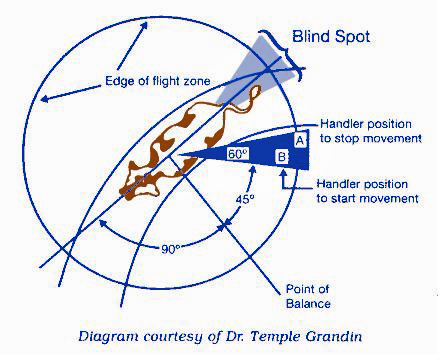
By Rob Eirich, UNL Extension Educator and Nebraska Director of BQA
Cattlemen know the importance of proper cattle handling and its effect on animal health and performance. Beef Quality Assurance has been implementing effective cattle handling (low-stress) into educational programs since its establishment in the 1980s.
The first thing livestock handlers must understand is cattle’s scope of vision. Cattle have nearly 360 degree vision with a blind spot directly behind them. Knowing this helps producers use positioning within the animal’s eye sight to direct them to move in the opposite direction.
Cattle also want to maintain a comfort zone around them. As objects move into that zone the animal tends to move away. Temple Grandin, a Professor of Animal Science at Colorado State University and a Livestock Handling Specialist, calls this zone the “flight zone” as seen in Figure 1 (http://go.unl.edu/shva). All animals have a different size of flight zone depending on the amount of pressure applied into the flight zone.
Producers also learn the “point of balance” which is normally the point of the shoulder with most cattle. As the handler is behind the “point of balance”, animals move forward, but as you move in front of that point, animals will move back. This combined with the “flight zone” makes cattle handling more effective whether on horseback, on foot, or motorized vehicle.
Curt Pate, Stockman and Stewardship Clinician, emphasizes the importance of handling cattle in a calm, patient manner to reduce the stress level of the animal and improve the effectiveness of cattle movement. Handlers need to maintain small, slow movements to apply pressure in and out of an animal’s “flight zone” to direct animals in the correct direction. Understanding cattle’s natural behavior will also make handling less stressful on animals and handlers. Remember, if you are working too hard take another approach to handling.
Handling facility design can also reduce stress of processing. No matter if you utilize a tub and snake, Bud Box, a combination of both, or neither, proper movement and handling practice can improve cattle movement. Never over crowd your handling system and remove distractions that cattle may see upon entering the facility.
The National Beef Quality Assurance website, http://www.bqa.org, has a number of videos available for more information on cattle handling, processing, and facility design.
For more information about Nebraska Beef Quality Assurance or to get BQA certification, contact Rob Eirich, UNL Extension Educator and Nebraska Director of BQA at the UNL Panhandle Research and Extension Center 308.632.1230 or reirich2@unl.edu.
For more UNL Beef information go to http://beef.unl.edu